| Heroes 5 Weaponry, Armory and Historic / Mythologic relations |  This thread is pages long: 1 2 3 4 · «PREV / NEXT» This thread is pages long: 1 2 3 4 · «PREV / NEXT» |
|
ZombieLord

  
   
Promising
Famous Hero
that wants your brainz...
|
 posted June 22, 2007 09:14 PM
posted June 22, 2007 09:14 PM |
|
|
Great thread, Elvin 
Oh and:
Quote:
and the devil whose weapon I'm not sure I know what it is
If you look closer, it's EXACTLY the same weapon as the Angel's (Great Sword), but the Devil is holding it reversed ... to show the Angel is the Devil's counterpart or what? ... to show the Angel is the Devil's counterpart or what?
|
|
Elvin

     
       
Admirable
Omnipresent Hero
Endless Revival
|
 posted June 22, 2007 09:42 PM
posted June 22, 2007 09:42 PM |
|
|
Actually the beta screens were easier to find  About the devil holding a reversed greatsword I don't agree though it may look the part. The grip is made of a wooden handle much like a staff. Maybe because the cross of the weapon is held in an inverted way as the opposite of the archangel..? About the devil holding a reversed greatsword I don't agree though it may look the part. The grip is made of a wooden handle much like a staff. Maybe because the cross of the weapon is held in an inverted way as the opposite of the archangel..?
____________
H5 is still alive and kicking, join us in the Duel Map discord server!
Map also hosted on Moddb
|
|
ZombieLord

  
   
Promising
Famous Hero
that wants your brainz...
|
 posted June 22, 2007 10:00 PM
posted June 22, 2007 10:00 PM |
|
|
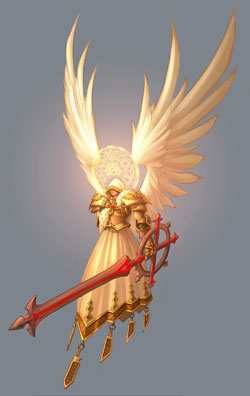
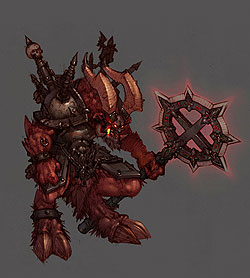
Ok, they are not EXACTLY the same (the Angel's is smoother), but the basic idea is that the Devil holds the Angel's weapon reversed
|
|
emilsn

 
     
Legendary Hero
|
 posted June 22, 2007 10:51 PM
posted June 22, 2007 10:51 PM |
|
|
Its not the same, but looks a like... So I would agree on it being reversed ...
____________
Don't walk behind me; I may not
lead. Don't walk in front of me;
I may not follow. Just walk
beside me and be my friend.
|
|
dkolb

  
  
Promising
Known Hero
Nay Nay and Aslan Protector
|
 posted June 22, 2007 10:55 PM
posted June 22, 2007 10:55 PM |
 bonus applied. bonus applied. |
|
hmm I have an idea why don't we talk about the origin of the creature's special abilities.
I'll do a couple and edit more later.
Note although alot of these have really clever origins, Nival mainly just borrowed them from Dungeons and Dragons, just like the latter borrowed them from the original sources before messing up their original meaning.
I am mainly concerned with the historical or mythological meaning behind the abilities.
Archer:
Scatter Shot

The Scatter Shot ability the archer has is a modification of the volley shot, which was used often as cover fire for infantry, as well as for assaulting enemies in towers. The principal was to rain down arrows on the target. Often these arrows were not accurate, so many archers would fire at once. These often claimed the lives of alot of calvary who did not have the mobility to escape the arrows. A perfect of example of this technique can be found in the movie 300. Archers from another island shoot so many arrows in a volley that it blots out the sun. Of course if you'll notice as with any creature in HOMM that has the "Large Shield" technique the volley technique is rather ineffective as the infantry could angle their shields so as to avoid most of the damage.
Marksmen:
Precise Shot

The fact that precise shot is included in the game shows that designers knew something about how crossbows worked.
The crossbow although invented long ago, was not improved upon significantly until the middle ages. I wouldn't say it was a novelty people knew about them and there were a few improvements but most armies preferred to use traditional archers.
However in the middle ages people began improving on the crossbow once again and the results were deadly. Although the traditional bow could fire faster than the crossbow, in the hands of anyone but a skilled archer was useless. With the crossbow soldiers could be trained in a week what it would take an bow archer many years. In addition the closer the crossbow shot was to the target the more deadly it became. Close range crossbow shots could embed in armor and cause excruciating pain. Because of this the crossbow in some instances became an equalizer of class because a simple peasant with a weeks training with a crossbow could kill an elite knight fully clad in armor who had trained his whole life! The church (in support of the nobility) for awhile condemned the crossbow as an "evil" weapon to prevent the above from happening. Obviously the church rescinded during war when they needed all the crossbowmen they could get. And to lead a brigade of crossbowmen was a great honor.
Manticore+Assassin
Poisonous attack:
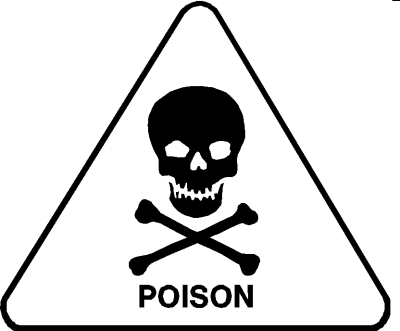
If you think the new Manticore is ugly check out the original!
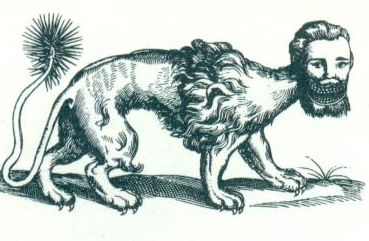
The idea of a manticore came from a old Persian Legend of a "horrible beast that was similiar to a tiger, had 3 rows of teeth, and a spiny tail that shot spikes at archers"
Because of this bizarre combination of animals was a novelty, later on throughout history various other "manticores" appeared. These ones having scorpions tales (thus the inspiration for the poison) as well as bat wings. It got it's human like appearance from some grotesque art that was drawn giving it the face of a woman. Later Dungeons and Dragons featured a creature that was similiar except possessing dragon attributes. And from then on various francises kept making their manticores but the norm became: Head vaguely human/lion, Body:lion, Tail: Scorpion, Wings: Bat or Bird and that's what is featured in HOMM3 and 5
The poison of the assassin can be traced to all sorts of ancient roots, but perhaps most interestingly Ninjas.
Ninjas performed very specialized assassinations and one of the most specialized was this:
Thy would cut a tiny hole in the roof of the bedroom where the target was sleeping and would lower a string down so that it hovered over the sleeping person's mouth and then they would slowly drip extremely deadly poison so that it would slide down the string and enter the guys mouth killing him in his sleep.
Pit Lord
Vorpal Sword:

"He took his vorpal sword in hand" and "One, two! One, two! And through and through / The vorpal blade went snicker-snack! / He left it dead, and with its head / He went galumphing back."
This was written in Lewis Caroll's "Jabberwocky", which was oddly enough intended to be a children's book.
Although it has never been proven as to what vorpal means from the source itself it is commonly associated with being a deadly sharp blade capable of cutting just about anything in half. A fitting ability indeed for one of the few truly fearsome looking creatures in the game.
Peasant/Enforcer
Taxpayer:

an homage to Feudalism.
Shieldguard
Shield wall:

A Shield wall was a military tactic most famously employed by the greeks as the phalanx, and by the Roman Legion as well. The Shield wall was a very effective tactic that help minimize losses on the battlefield. Unfortunately it became less and less used when heavy calvary became trained because the horses could break into the formation. It is then when the shield wall became replaced with pikes (which the horses wouldn't charge against) and shields became less and less useful.
Squire
Shield Allies:
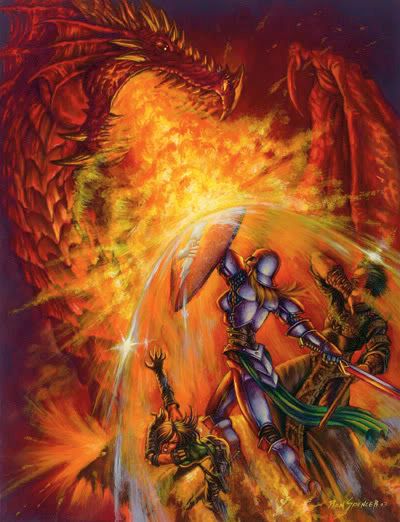
Although they eventually fell out of favor, heavy shields were widely needed as they offered protection from projectiles of all sorts. Not only that but they could absorb the shock of alot of hand to hand weaponry.
The type the squire has in HOMM5 is impressive but would be no means be able to offer very much protection to the poor archers, although he could protect himself quite well.
For the archers they use HUGE shields called pavise that were almost as big as they were!
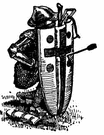

However this does not make the Shield Allies ability untrue to life, only that the archers would have their own shields and the crusaders wouldn't stick around waiting to defend the archers.
Deep Hydra
Regeneration
Lizards truly are remarkable creatures. I attribute the deep hydra's ability to the same ability lizards have in real life. If their tail is cut off they simply regenerate a new one. Hmm... the multiple heads of the hydra are similiar to the 8 tentacles of the octopus and if I recall some of those can regenerate as well.
Wow Nival actually thinking of something that makes sense and is *gasp* orginal?!
Moderator's note: QP awarded for overall contributions of threads on this page.
|
|
Elvin

     
       
Admirable
Omnipresent Hero
Endless Revival
|
 posted June 22, 2007 11:15 PM
posted June 22, 2007 11:15 PM |
|
|
I added alchemist85's find, the katar in the master post. Also I must thank VokialBG and dkolb for contributing in the thread. It's coming along pretty nicely and it's educational as well 
____________
H5 is still alive and kicking, join us in the Duel Map discord server!
Map also hosted on Moddb
|
|
dkolb

  
  
Promising
Known Hero
Nay Nay and Aslan Protector
|
 posted June 23, 2007 05:39 AM
posted June 23, 2007 05:39 AM |
|
Edited by dkolb at 23:53, 23 Jun 2007.
|
Paladin
Lay Hands:

Lay Hands or more specifically the Laying on of hands is a tradition that began in Judaism and is still used today in many Christian Churches.
In Judaism the laying on of hands was used as a blessing and granted power of authority.
But in Christian Circles, the laying on of hands had many purposes.
In the new testament it was associated with the receiving of the Holy Spirit. This was called the day of Pentecost. I mention this because a branch of Christianity are called Pentecostal and are part of the Charismatic movement. They would think very highly of the paladin because they too believe that the laying on of hands can heal a person fully and remove any harmful effects from them 
In many Christian churches they believe that laying on of hands is a good thing to do if nothing else then to show compassion and empathy but they view it almost as a prayer or asking God for his healing, whereas pentacostals believe that there is divine power within the touch itself.
Paladin,Champion, Cavalier
Jousting:

I happened to glance at the wikipedia page for jousting and they for the most part have it right except for some things:
Not everyone who jousted was a knight. There were many instances were people who were not knights or even nobility jousted. And for good reason. Those who won at jousting or in the arena were Champions (not Paladins) and were very highly regarded and sought after regardless of upbringing. A Champion could marry into nobility and riches because of his fighting skill which was always in great demand back in those days. 
As the risk for injury was very high, all participants in a joust wore very heavy plate armor. The Cavalier in HOMM5 would sadly not last very long as they are wearing no face protection and chain mail. The Paladin is an improvement but is wearing atypical plate mail and not all of his torso is covered, his helmet looks awesome but would be a hindrance in a joust. The Champion is most accurate to his historic roots, although Heroes 2,3, and 4 were very historically accurate with what they would have looked like. I'm not ragging on Ubi/Nival either I like their portrayal of them alot I'm just talking about historically speaking.
Wolf
Howling:
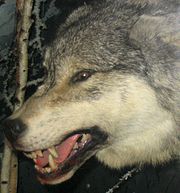
Howling is used for communication in heavily forested areas or areas where the wolf needs to communicate over long distances. It is also used to signal territory. Interestingly howling indeed often summons other members of a pack to a specific location. Large Packs will howl more often than smaller packs. The reason for this is because other packs will also respond to the howl. If the other pack is much larger it could be dangerous that's why wolves in smaller packs are not as likely to howl.
Mummy
Hexing attack:

comes from the idea that mummies have the power to curse the living. In historical times legends were told of grave robbers being killed by mummies or cursed so that they would begin to rot. These were often told to keep grave robbers from entering the tombs and pyramids. Although many pyramids were indeed vandalized, some of them remained completely intact possibly proving that the curse was real or at least that grave robbers were gullible.
Lich
Death Cloud:

I don't know exactly where the origins came from but it seems very similiar to the black death or the plague. Many superstitions and horror stories about a grim reaper type figure that brought death came about in the middle ages in the midst of the Black Plague.
A Lich itself comes from the old english word lych which means corpse. Only in subsequent fantasy did Liches take on the attributes of what we know them as in HOMM.
Silver Unicorn
Blinding Attack/
White Unicorn
Bond of Light:

The unicorn is an interesting combination of a representation of strength but yet of purity.
It is first mentioned in the Bible in the old testament as a horned creature that was known for it's strength and was not able to be tamed. (As a side note the Behemoth is a Biblical Creature as well)
Curiously many ancient sources including the chinese and greeks claim that this animal or an animal with one horn similiar to it did indeed exist.
Regardless of whether it existed long ago, in the middle ages various legends began to become associated with it. The most famous being that only a virgin girl with a pure heart could tame it. This is how it became associated with purity chastity and light. It could only be bound by the light of the virgin hence "bond of light". The Blinding attack could be a reference to being stabbed by the horn or being blinded by the brightness of the unicorn. The unicorn isn't traditionally associated with blindness but it is traditionally associated with the color white, therefore making "White unicorn" unoriginal but mythologically accurate. As a sidenote the most sought after part of the unicorn was it's horn (which is of course very much likened to a narwhal's)
Anyway the horn was thought to posses very powerful healing powers. Throughout history the significance became diminished until it became a "possible cure for poison"
Blood Maiden/Blood Fury/Blood Witch
Strike and Return:

The origins of this technique (which the harpies were great at too) is rather fascinating as the real people who were the true masters of it were once called Skirmishers. (not to be confused with the Fortress Creatures)
A Harpy hag on her worst day I'm afraid had nothing on Skirmishers who were specifically trained to harass opposing troops and infuriate them. Skirmishers would have light wooden shields if any would be extremely fast and agile and were almost completely random. Some would have crossbows, others javelins, spears, rocks, slingshots, old rusted swords, just about anything they could get their hands on. They would rush at from all sorts of crazy directions and start to inflict casualties and then they would immediately retreat back into the main line of the army. They were often mercenaries, rogue,commoners, or even convicts, and were not well thought of to say the least. Although they killed some of the enemy that wasn't their purpose. Their purpose was to enrage the enemy so much that they would charge after them which was exactly what the skirmishers wanted because they would draw them away from their main army and they would be outmanuevered and decimated. Formations could be broken and skirmishers could be indirectly reponsible for thousands upon thousands of casualties.
To the much stronger section of the main force skirmishers were thought of as cannon fodder, and they often were. And once they were used other armies began using them so the skirmishers would fight each other as well as the army. Finally it is important to note that calvary specifically hated them because the rider often would be mentally strong enough not to break rank, but the horse after being pelted by stones and arrows would lose control.
|
|
emilsn

 
     
Legendary Hero
|
 posted June 23, 2007 09:37 AM
posted June 23, 2007 09:37 AM |
|
Edited by emilsn at 15:32, 23 Jun 2007.
|
Wauw this post getting better and better!! .. Love it This need some more quality points 
EDIT: maybe i could get a Quility points, atleast i ride a basilisk!!
____________
Don't walk behind me; I may not
lead. Don't walk in front of me;
I may not follow. Just walk
beside me and be my friend.
|
|
Elvin

     
       
Admirable
Omnipresent Hero
Endless Revival
|
 posted June 23, 2007 11:30 AM
posted June 23, 2007 11:30 AM |
|
|
I second that!  I'm glad to see I knew most, I only missed the fact that pikes replaced shield formations as a cavalry counter and where lay on hands originated from I'm glad to see I knew most, I only missed the fact that pikes replaced shield formations as a cavalry counter and where lay on hands originated from 
____________
H5 is still alive and kicking, join us in the Duel Map discord server!
Map also hosted on Moddb
|
|
dkolb

  
  
Promising
Known Hero
Nay Nay and Aslan Protector
|
 posted June 23, 2007 12:37 PM
posted June 23, 2007 12:37 PM |
|
|
added some more
next up berserker rage
|
|
Orfinn

 
    
Supreme Hero
Werewolf Duke
|
 posted June 23, 2007 02:01 PM
posted June 23, 2007 02:01 PM |
|
Edited by Orfinn at 14:01, 23 Jun 2007.
|
Great thread Now I learned a bit more about medieval weaponry and armour Now I learned a bit more about medieval weaponry and armour 
____________

|
|
Elvin

     
       
Admirable
Omnipresent Hero
Endless Revival
|
 posted June 24, 2007 12:17 AM
posted June 24, 2007 12:17 AM |
|
|
I've got to give it to you, you've got a good taste in pics dkolb 
____________
H5 is still alive and kicking, join us in the Duel Map discord server!
Map also hosted on Moddb
|
|
dkolb

  
  
Promising
Known Hero
Nay Nay and Aslan Protector
|
 posted June 24, 2007 12:29 AM
posted June 24, 2007 12:29 AM |
|
|
Berserker
Berserker's Rage:

Berserkers were the famed norse warriors who fought in an state of intense rage. The term berserker is said to mean "bear's skin" as the warriors rarely fought with any sort of armor (except usually a helmet or a pelt of an animal) Some attribute the act of going berserk as being similiar to spirit possession. The two animals thought to posses berserkers were the wolf and the bear. In HOMM5 this may have been the inspiration for the bear riders and the idea of runes being able to grant additional powers.
Berserkers showed no fear in battle and attacked friend and foe alike. They were especially proficient with axes and their presence was very intimidating to the enemy who could not match the berserker's ferocity.
Stone Defender
Prepare Position
Hold Ground
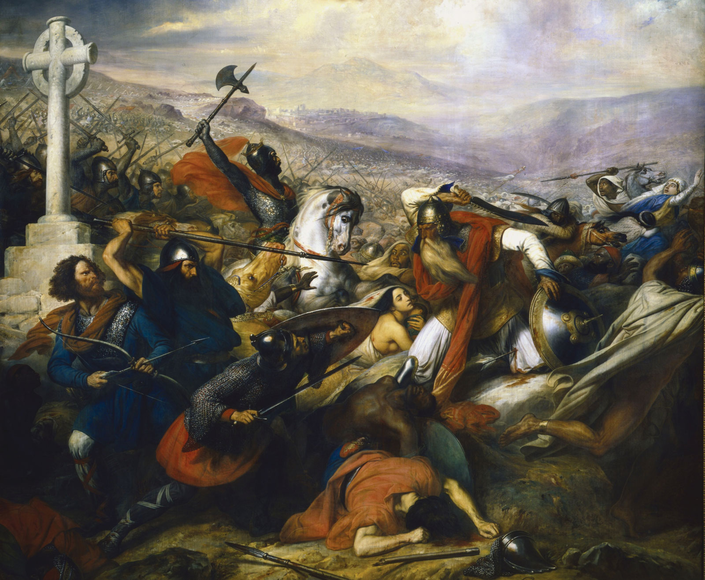
Did you know that most of us are alive to enjoy HOMM because one man prepared his position in battle and held his ground? And by most of us I'm not talking about the USA but much of Western and Easter Europe as well. The man's name was Charles "The Hammer" Martel, and He looked and acted alot like Wulfstan in HOMM5 except he was even more of a tough son of a gun. His army who wore bear and wolf pelts and probably were alot like the dwarfs in fact saved all of western europe.
At this time the Arab army was the greatest in the world. They had the best calvary, and they seemed like an unstoppable force. At this time Christendom was for the most part busy fighting with each other and Arab armies had no trouble killing all of them without a sweat. Knowing war was on the horizon a few years before it happened, Martel began training an elite infantry force.
Besides this force Christendom had no other army even close to being able to defeat the Arab armies and so Martel's force was the last hope for his religion.
This came to a head at the battle of Tours.
Martel managed to inspire his men to stand firm against a force which must have seemed invincible to them, huge mailed horsemen, who, in addition, probably vastly outnumbered the Franks. In one of the rare instances where medieval infantry stood up against cavalry charges, the disciplined Frankish soldiers withstood the assaults even though, according to Arab sources, the Umayyad cavalry several times broke into the interior of the Frankish square.
Finally the Arab forces retreated and Martel strongly reinforced and fortified kingdoms that would last for years to come.
You may be asking, so what? How does that effect me? It effects you in the following ways:
If Martel's force had been defeated the Arabs would have take over the entirety of western europe.
Martel's sucessor Charlemagne would have never been born.
Charlemagne brought with him a love of learning and founded school, and learned how to read and taught everyone to enjoy learning.
Many cultural improvements both secular and Christian came about because of these learning institutions. So the world would have been much much different in many ways. I would not have even been born since I'm of german origin and where germany was would have been under Arab control. So you wouldn't be reading this at the very least lol
|
|
emilsn

 
     
Legendary Hero
|
 posted July 28, 2007 06:30 PM
posted July 28, 2007 06:30 PM |
|
|
So I dont know what this kind of Catapult is called in English but i know the catapult is better then the old one... So anyone got some info on it?
____________
Don't walk behind me; I may not
lead. Don't walk in front of me;
I may not follow. Just walk
beside me and be my friend.
|
|
alchemist85

 

Hired Hero
Disciple(s II) of Desert
|
 posted July 29, 2007 10:14 AM
posted July 29, 2007 10:14 AM |
|
|
I previous parts cataluplt was just a catapult. In HV it's not. The siege weapon we can see in HV is called trebuchet. It's constructed a bit differently than catapult and so works in a bit different way. But the effect is the same: to crush enemy's walls 
Nevertheless calling it catapult is a bit of mistake, but who cares? 
I hope that you're satisfied. I also add link to some wikipedia info:
[url=http://en.wikipedia.org/wiki/Trebuchet]Trebuchet[/url]
____________
|
|
MornVatreniVuk

 
 
Adventuring Hero
|
 posted September 06, 2007 12:43 AM
posted September 06, 2007 12:43 AM |
|
|
Ah, just like home... I'm a bit of a medieval weaponry freak. I'm a bit of a medieval weaponry freak.
Axe, Sword, Spear... Luv them all.
|
|
Orfinn

 
    
Supreme Hero
Werewolf Duke
|
 posted September 06, 2007 01:17 AM
posted September 06, 2007 01:17 AM |
|
|
Cool! Now abilities too  Love the berserking part, a nice tradishion for us crazy folks up north Love the berserking part, a nice tradishion for us crazy folks up north 
____________

|
|
roy-algriffin

 
    
Supreme Hero
Chocolate ice cream zealot
|
 posted September 06, 2007 01:25 AM
posted September 06, 2007 01:25 AM |
|
|
Quote:
Martel's sucessor Charlemagne would have never been born.
Charlemagne brought with him a love of learning and founded school, and learned how to read and taught everyone to enjoy learning.
Many cultural improvements both secular and Christian came about because of these learning institutions.
Hmm i wonder if he would have thought twice if he knew what kind of teachers there are around today
____________
"Am i a demon? No im a priest of the light! THE BLOODY RED LIGHT"
|
|
nocaplato

 
 
Adventuring Hero
Lover of Ancient Philosophy
|
 posted September 06, 2007 04:54 AM
posted September 06, 2007 04:54 AM |
 bonus applied. bonus applied. |
|
Ouch, that last post about teachers, jeez, someone had some bad experiences in school. Hate to think that all those people who bled and sweated have been generalized into a single ineffective and uncaring group. After all, those who do, do and those who can't teach, right? By the way, I'm a teacher (use a capital 'I' when using the 1st person pronoun). Hope everyone forgives me. Er...
I've been wanting to contribute a bit to this forum for a while now, and so I thought I'd throw an extra tidbit in now. What I'd like to address are the origins of some of the creatures (and sometimes) some of the possible symbolic interpretations from a psychological and literary perspective... bear with me, hopefully it'll be fun.
Dungeon ('cause they're my favorites):
Assassin
The original word for assassin comes from Arabic, Hashashin. The first assasins were members of a secret sect created by Hassan Sabbah. They were from northern Syria during the 11th century and were a Shi’ite group of muslims. Hashashin means ‘hash smoker’because it was said that Hassan Sabbah would send out members of his sect on suicide mission after inducing single-minded devotion through extreme… er… stoner-ism.
Hassan Sabbah used his devoted followers primarily to eliminate political rivals or to stir political events, so eventually the word was altered in Europe and became specifically associated with those who killed for political or economic gain, and thanks to the cold war, spies and the romanticized lives of people like James Bond...
Incidentally, some believe the application is a complete misnomer used by Hassan Sabbah's enemies (particularly Sunni enemies) who spread the rumors about hash use in order to disparage him and his followers.
Blood Furies
The Blood Furies, as such, do not exist, in normal mythology, however, there are such things as ‘The Furies’ in both Greek (and, of course Roman) mythologies. Furies were also known as the Erinyes as well as the Eumenides (as described by the Greek playwright, Aeschylus). The Furies were depicted in various ways, primarily as three sister goddesses (similar to the Fates or Norns) whose primary role was punishment and vengeance against wrong-doing when mortals could not complete justice on their own. They were notoriously stern and unforgiving to those they sought and against whom they meted out justice, though not always completely without compassion.
Particularly in Ancient Greek society, the Furies were responsible for, and took special relish in, bringing to justice those who had committed crimes against the family (the highest sin to the Greeks was patricide followed by the other filial murders). Like many creatures of vengeance the Furies would dole punishment that seemed to fit the crime.
Incidentally, the change from harpies to dark elven hotties may be partly due to the Erinyes appearance in the 1st edition DnD monster manual, which shows the furies as winged, nude women. Harpies, of course were foul woman-like birds, so Nival’s progression to Furies seems to have some thread to its current incarnation.
Symbolically the Furies are represent punishment and justice, primarily for the victims and as a deterrent warning for the would-be criminal. As symbolic, shrewish women, the Furies represent the first law of our lives, the mother (even our modern symbol of justice is feminine in the form of the blindfolded goddess Themis). Further, because they are a mother figure they represent a powerful symbolic admonishment against the harming of a mother or father. While symbols of destruction and punishment, the Furies also represent the possibility of redemption and forgiveness. Through them, even the most hideous of crimes could be atoned for, if the criminal is only able to stand up to their harsh form of justice… so they become at once both a symbol for death and rebirth.
Addendum
By the way, the origin story for the Furies is focused on several titans. Ouranos and Gaia had several monstrous offspring, prior to the ascension of Zeus and his Olympian Gods. Ouranos imprisoned his offspring and Gaia called on the other titans for aid. Kronos responded, and attacked his father, lopping off his genitalia, and hurling the part into the sea. From the blood and phallus sprang the Erinyes, thus they were born out of crimes against family (imprisonment) and their birth is metaphorically a punishment (castration). They were doomed to their role from the start it seems.
Minotaur
Originated with the Greek mythology, though examples of half animal/half human creatures can be found around the globe and from all different cultures. Minos was King of the island of Crete, whose patron saint was Poseidon. Poseidon gave Minos a beautiful white bull, which the king was supposed to sacrifice, but King Minos couldn’t bring himself to destroy the creature. As punishment, Poseidon cursed Queen Pasiphae to fall passionately in love with the bull, and after a coupling, the Minotaur was born as a bastard son to the queen.
Ashamed and furious, Minos hired the architect Daedalus to build the labyrinth, a complex maze, from which the Minotaur could never escape, and no one else could find proof of the queen’s animal infidelity. Unfortunately for Minos, the curse did not end here, because he had to pacify the beast. Every year he had to offer seven female virgins, and seven young men upon which the minotaur could feast.
Eventually this was put to an end by the Athenian hero Theseus, who, with the help of Minos’ daughter, was able to track the minotaur in its layer (using a ball of twine as a guide to the exit) and slay the creature in hand to hand combat.
Symbolically the Minotaur is a representation of subconscious animal drives, particularly hunger and sexual taboo. The labyrinth is a symbol of the mind, with it’s convoluted twists and turns, into which Minos attempted to force his and his queen’s shame (this is called ‘Repression’ in psychological terms). The fact he cannot actually perfectly suppress his early sins is shown by the loss innocent young adults, arising year after year, much like the way guilt for our past actions haunts us until we can atone somehow (for Minos atonement comes in the form of the hero Theseus).
Grim Raider/Rider
Well, sorry to disappoint anyone, but there really isn’t anything in mythology like the dinosaur riding dark elves, they’re just damn cool. Dinosaurs themselves are a concept as young as the 19th century with the inception of rationalism and a belief that science could win out over nature… thus the fields of archeology and paleontology are new to the scene (far too new for a real mythos). However, lizards and serpents can be found in references from all over the place, and with almost no real agreement as to their inherent moral traits. Ancient Egyptians, Romans and Greeks, for example loved lizards, the Egyptians in particular worshipped crocodiles as gods in some cases. On the other hand the Judaic people, Christians and Muslims view any and all reptiles with revulsion and as a source of incredible evil.
An interesting idea to think about (and that fits the Dark Elf evil nature) comes from Genesis, in which the lizard is cursed to crawl on its belly only after having seduced Adam and Eve into eating from the tree of knowledge. Thus, it’s possible the original creature snake had some sort of legs, or stood upright somehow. Maybe that’s where those things come from?
In any event, the symbolism of lizards is often as varied as our cultural interpretation, however in western cultures, the Lizard is a symbol for pure amorality. Because lizards operate (or seem to by Judeo-Christian points of view) on such a fundamentally instinctual, even evil, level, the Lizard (or Dinosaur in this case) quickly becomes a dark force. Serpents are frequently equated with the devil and demons through out western religious thought, and because of their cold-blooded nature (a phrase synonymous with unfeeling in the extreme) it is easy to see how ‘lizard thinking’ or ‘serpentine nature’ become symbols for all sorts of dark intents. At the same time, however, the regenerative nature of lizards (i.e. the regrowth of the tale) also suggests some sort of renewal, but renewal for the worse. The Lizard then is a symbol of recurring destruction that may come in waves, but will always return in full force at some point.
An afterthought
Metaphorically, the Dark Elven riders of these serpents must be able to master their lizard mounts, so it must be they are able to master devils and demons. Added to that is the adjective 'Grim' of dark, serious, foreboding, so the 'Grim Riders' are, all in all, a pretty nasty lot.
Hydras
The hyrda is among my favorite, symbolically at least.
The hydra is the offspring of Tyhpon, his grandfather is Ouranos, grandmother Gaia (see the Furies addendum). The hydra was a great 'water snake' who lived in a swamp called Learnia. There it dwelled as a threat to nearby travellers, farmers and fishermen until the hero Herecles (Hercules) was set out to destroy it as one of his twelve (or is that ten?) labors. In a massive battle Herecles fought the hyrda by chopping (or bashing, depending on the version of the myth you read) its heads off. However, the hyrda was virtually immortal, capable of regenerating so that if a head were chopped/bashed off, two more would grow in its place.
Finally, Herecles was able to defeat the hydra with the help of his young nephew Iolaus. Herecles would slice off one of the heads and Iolaus would scorch the stump with a flaming brand, preventing the head from regrowing. However, when Eursytheus found that Herecles did not work alone, and that it was his Iolaus who actually scorched the stumps, he declared this particular labor invalid, squeeking out yet one more major chore from the hero. What a jerk that guy.
The hydra was also said to have poisonous blood, into which he Herecles dipped several of his arrows (and which would later lead him to losing the love interest of the Amazonia queen, and causing a huge war between himself and the Centaurs... if I remember rightly).
Symbolically the hydra is relatively straight forward, but powerful. Any problem we are faced with has the tendency to have hyrdic properties, such that if we solve a problem, several more seem to pop up in its place. The more complex a problem, the more heads your hydra has, and the harder it is to keep more heads (i.e. problems) from growing back. Anyone who's done any scripting will, especially of several hundred lines or more, will recognize this kind of situation where it seems like each problem we solve only generates several more.
The symbolic meaning can also apply to the types of solutions we use. Sometimes a solution to an immediate problem only causes several other problems to arise in place of the first. For example, solving the test taking problem by cheating might end up in being caught, flunking, not knowing what you're supposed to know, getting expelled, etc., and often will end up in a cascade of other related, but more complex problems.
Dragon
Dragon mythology is incredibly widespread, found in Greek and Roman, pre-Columbian Americas, Slavic, African, Middle-Eastern and Chinese cultures. Because of the dragon’s incredible range of cultural influence the origins and myths are similarly broad and complicated. Typically, however, dragons can be broken down into basically two types in our modern collective awareness, that of the Western Dragon, and that of the Eastern Dragon.
With little doubt, the Black or Shadow dragons are of the Western type, so I’ll confine this discussion to just that face of the dragon myth. Dragons are attributed a broad range of powers and traits, but generally they are thought to breath fire, have great wisdom or cunning, wield some form of magic or other, are lizard-like, with bat wings and spiked ridges on their backs. Western dragons are often depicted as having either two or four legs, though occasionally they are shown as serpents with wings.
Western or Euro-centric (including Slavic and Middle-Eastern types) are typically of an evil nature, dark and cave dwelling creatures, dragons are said to hoard gold and treasure and occasionally consume or covet virgin women. The origins of these sorts of dragons are difficult to isolate, some are natural powers or existent from the moment of creation, others are potential offspring of demonic or devilish trysts.
Much of western though from the middle dark ages onward view dragons as a descendant or version of the devil (though the Norse also believed in the world serpent, worth noting for later discussion. The World Serpent was a sea serpent off spring of the mischievous Loki.) Because of its serpentine nature (i.e. wyrm or worm in old English, Celtic and German) the Dragon in western culture is very often associated with the devil, perhaps even a derivation of the serpent occurring in Genesis who tempted Adam and Eve. Additionally Catholic saints are occasionally referred to as dragon slayers in the chivalric tradition, perhaps the most famous of which is Saint George, still celebrated across continental Europe as well as Britain and the Mediterranean Middle East.
Symbolically the western dragon is the deep monster, a creature preventing out better natures from gain. It is the “bogey-man” we can’t get around, the darkness of our own natures or souls that prevent us from attaining that which is truly desired (e.g. love, success, power or money). It is the ultimate psychological incarnation of evil and greed. Even worse, however, the dragon is a hoarder, meaning not only does it lust for treasure, it lusts for treasure for the pure sake of owning it, rather than to better itself or its surroundings, or even for its personal gain. Therefore the dragon can also symbolize gradual poverty or the shift of wealth from use to paralyzation. Dragons, however, or no mere misers, they are far more sinister and powerful than your cranky old uncle/aunt who won’t help you get out of a jam. No, dragons are creatures of such strength that they are beyond our realm of control, so they come to represent elements of our societies without compassion or a need to bow to ethics or power in any form but another ‘dragon entity’.
The less malevolent dragons of some cultures (pre-Columbian American dragons and some incarnations of Slavic dragons particularly) are a far friendlier lot. Because they are composed of opposites (i.e. the flying nature of birds or bats verses the crawling nature of snakes) they can also come to symbolize personal transcendence, or the overcoming of our own greedy and lustful natures. In some sense they show the ability to move from the dirty ground into the higher ideals of the air and approach heaven. Additionally the World Serpent and other dragons that circle back on themselves to bite their own tails can be seen to represent eternity, representing rising and falling cycles of the natural world as well, from beginning, to end, to beginning again, much like the seasons of nature of the cycles of day and night. Therefore some dragon symbols can be interpreted as depicting positive life cycles and death-rebirth dichotomies.
Witches
I've put off any comment on wishes because, honestly, I know the least about them. Also, witches are not really a mythological creature, but a social offshoot of any culture who believes in a) the use of magic as a practice, or b) a dualistic view of metaphysics (such as a 'Heaven v. Hell' religious system). If you're interested in more detail you should look on the wikipedia site:
http://en.wikipedia.org/wiki/Witchcraft
I'd like to mention just a couple things as I see them relating to the HoMM witches, with just a quicky comment on Shakespeare's Macbeth.
First, witches are always capable of casting spells and are catagorized broadly into two types: black witches, who cast curses on their enemies, and white witches, who cast beneficial spells on their friends. Both these elements are obvious in the Shadow Matriarch with their use of both Dark Magic and Light Magic, and serves to explain why Nival has incorporporated both types of spells in a Dark Elf unit (after all, Warlocks are focused on Destruction and Summoning, not Light or Dark). But, perhaps more interesting, Witches in tradition are often spell casters who differ are deviate from the normal acceptable type of spell-craft a culture believes in. Thus, the witches of the Dark Elven realm are incapable of casting spells associated with their faction exactly because they are deviants.
From a literary perspective, I feel the most notable footnote about witches should mention Macbeth. In it, Macbeth encounters three 'wierd systers' (or wyrd sisters, equating them with the Norse 'Norns' and the Greek 'Fates'). If you've never read or seen it, Macbeth is about a king who is given a prophecy of inevitable success by three witches capable of casting dark curses and the ability to scry or divine future events. Macbeth acts on the prophecy at the urging of his wife, resulting policitically in three murders (there's that number again) which serve both to elevate and, eventually, destroy this would be king. The witches in the play are given a decidedly dark mood, found first on a darkened heath after a bloody battle and second in an underground cavern where Macbeth demands more clarity about the prophecy he was given. The witches give him the prophecy which deludes Macbeth into thinking in dualstic terms, such that he believes in success when the opposite is the truth of the prophecy. The duality implied here in the witches seems to echo very well the social truth of witches as well as Nival's decision to give them access to opposed magic forms.
Overview and Whatever
Well, as is mentioned in the thread linked below, a touch on Tolkien's influence has to be part of this. Elves in most cultural myth systems are little guys who help out old shoe makers or scamper around in the forest somewhere or make cookies which are remarkable for their factory-like packaging and TV commercials. Then comes Tolkien. Tolkien, by the way was not simply a writer of great stories, but a Philologist, or a scholar of languages. In particular he spent his energies on English literature and language as far back as he could stretch. Fortunately for us lovers of his stories that main scholarship focused on Beowulf and the Germanic Norse mythologies. According to the Norse, Elves were variably either dwarf like or more human-like in appearance. In either case they were immortal or virtually immortal and had access to magic, especially fine crafts. In any event, his interpretation of those mythologies and language roots led to an interpretation of elves such as the roleplayers (and pop culture too, thanks to Peter Jackson) see them now, tall(by dwarven standards at least), beautiful, capable of creating great art and infused with magic and life. Thank goodness for Tolkien's input, or just his alteration of the stream, I'm a great elf lover ever since I read the Hobbit.
Since the 40s and the 50s elves of Tolkien's type have dominated our popular consciousness. So far as I know, it wasn't till the 90s that a thing like the Dark Elves came to being... someone help me here! I've never read any of the stories of Drizzt Du'ordern (spelling?) but I do know of the Drow, the Dark Elven grandparents. The Drow are creations of the 1st edition D&D, perhaps by Gary Gygax himself, though I once met a black man who claimed to be the progenitor of a black elven species... pure exaggeration perhaps, but worthy of note if for no other reason than the racial bias in D&D. That racial bias seems to be played out in HoMM games ever since the beginning. Very few heroes or creatures are of non-white stock, though there are a few (one knight in HoMM2 stands out to me now). Do geeks realy just come from cold European lands or American small towns mostly? I have no idea if any of that is true, but apocryphal evidence seems to suggest it.
Departing from some very sensitive subjects, the dark elves strike me as a very well unified racial category in HoMM. There are both Shadow and Black Dragons, Shadow Matriarchs, Grim Riders/Raiders, Deep Hyrdras and Assassins (who strike from the dark). Each of these suggest darkness or directly relate to darkness or shadows. Minotaurs are creatures of the subterranean realm as well, hidden in twisting mazes, while the Furies' description of 'Blood' is certainly not a positive word. Coupled with that, a large number of these are directly equated with blood and demonic natures. The snake-like qualites of three of its troop types, the Raider, Hydra and Dragon connect it with the devil again and again, while the Witches are a direct connection to devilish or abherrent powers. Even the Furies are associated with the dark duality of punishment (or as demons of a sort). Only Assassins and Minotaurs have no direct cultural or mythological connection to the infernal, though I'm sure an argument could be made in either case.
Maybe the Dark Elves and the Kreekans are closer than we thought.
more to come... if y'all are interested.
|
|
alcibiades

    
      
Honorable
Undefeatable Hero
of Gold Dragons
|
 posted September 06, 2007 10:18 AM
posted September 06, 2007 10:18 AM |
|
|
That was very interesting.  I consider myself pretty well versed in general mythology, but lots of things there I didn't know. Please bring more, if you feel like it. I consider myself pretty well versed in general mythology, but lots of things there I didn't know. Please bring more, if you feel like it.
Oh, and you might be interested in seeing this thread also.
____________
What will happen now?
|
| |
|
|





